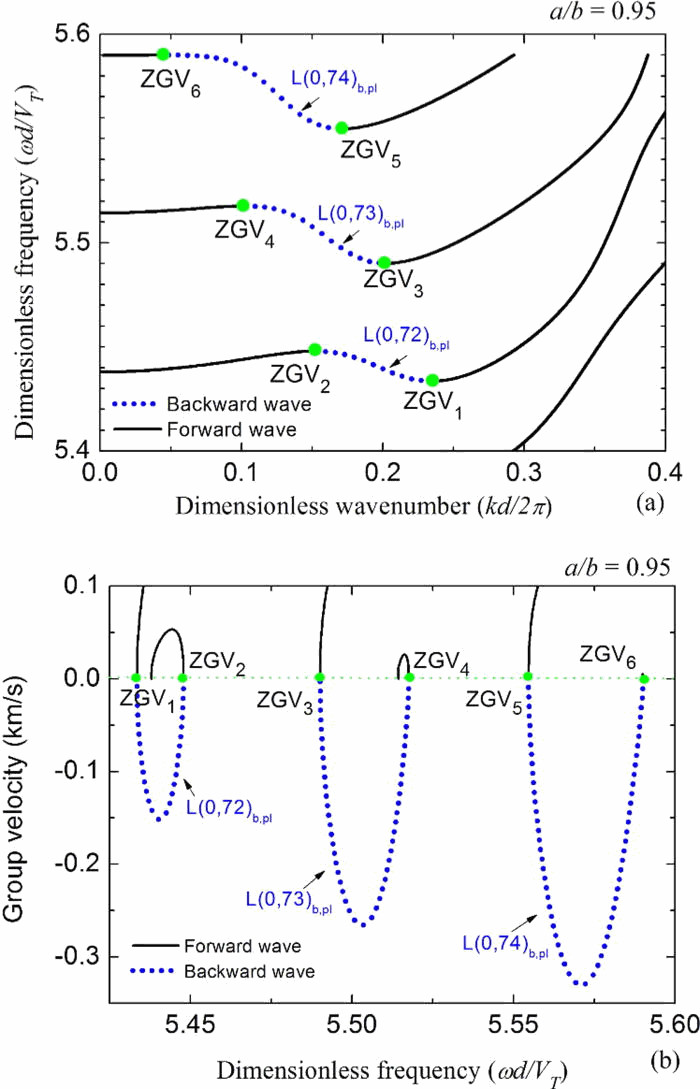In the frequency-wavenumber (![]() ) spectra, a dispersion curve of a guided wave may exhibit a portion of negative slope, where the group and phase velocities are directed in the opposite directions. This phenomenon is termed “backward wave propagation” or “negative group velocity.” A related phenomenon is the zero-group-velocity (ZGV) point where the slope changes sign, that is, the group velocity vanishes at a nonzero wavenumber.
) spectra, a dispersion curve of a guided wave may exhibit a portion of negative slope, where the group and phase velocities are directed in the opposite directions. This phenomenon is termed “backward wave propagation” or “negative group velocity.” A related phenomenon is the zero-group-velocity (ZGV) point where the slope changes sign, that is, the group velocity vanishes at a nonzero wavenumber.
At these ZGV points, the acoustic energy of the corresponding ZGV modes is trapped in the source area without any transfer to the adjacent medium. The resulting resonance is sensitive to local mechanical properties and dimensional changes of isotropic and anisotropic materials.
Recently, laser excitation and detection of such ZGV modes has attracted considerable attention with the prospect of the application of this phenomenon to measure elastic constants and structural defects of thin plates, hollow cylinders, solid transversely isotropic cylinder, and multilayered plane structures.
Liquid-filled pipes used in the civil and energy industries need to be inspected regularly to certify their safety and reliability. For hollow cylinders, a non-contact, laser ultrasonic technique based on ZGV Lamb modes has been developed for non-destructive evaluation application. The objective of this work is to study the effect of a contained liquid on backward waves and the associated ZGV modes, and thereby to investigate whether this ZGV technique can be used for in-service inspection of liquid transportation pipelines.
In recent days, researchers CUI Hanyin, LIN Weijun, ZHANG Hailan and WANG Xiuming from the Institute of Acoustics of the Chinese Academy of Sciences and Jon Trevelyan from the School of Engineering and Computing Sciences of Durham University provide a theoretical and numerical investigation of the influence of the contained liquid on backward waves and associated ZGV modes, in order to explore whether this ZGV technique is suitable for in-service non-destructive evaluations of liquid-filled pipes. Research results have been released in The Journal of the Acoustical Society of America (Vol. 139, No. 3, pp. 1179-1194, 2016).
Through analysis of dispersion spectra and excitation properties, it is found that the presence of the liquid causes an increased number of backward modes and ZGVs which are highly excitable by a point source. In addition, several guided modes twice undergo a change of sign in the slopes of their dispersion curves, leading to two ZGV points. This phenomenon of double ZGVs in one backward wave, which is caused by strong mode repulsions, has not been found in isotropic hollow cylinders. But it can be observed in a fluid-filled thin-walled pipe, as shown in Fig. 1. From the excitation analysis, it is concluded that backward modes and ZGVs are highly excitable by a point source which is placed centrally in the liquid-filled pipe. This implies that the ZGV technique has the potential to be applied for in-service inspection of pipelines which are carrying liquid.

Fig. 1 Dispersion spectra (a) and group velocity dispersion curves (b) of the three backward modes in the steel pipe filled with water. Each backward mode has two ZGV points. The inner and outer radii of the pipe are a = 9.5 mm and b = 10 mm. The dotted and solid lines represent backward and forward modes, respectively. The green dots denote ZGV points (Image by CUI).
Funding for this research came from the 2009 Newton International Fellowships and Follow-on Support, the National NaturalScience Foundation of China with Grants No.11474303 and No. 11134011, the National R&D Projects for Key Scientific Instruments with Grant No. ZDYZ2012-1-07, and the “12th Five-Year Plan” period for informatization project in supercomputing key demonstration, Chinese Academy of Sciences with Grant No. XXH12503-02-02-2 (07).
Reference:
CUI Hanyin, LIN Weijun, ZHANG Hailan, WANG Xiuming and Jon Trevelyan. “Backward Waves with Double Zero-group-velocity Points in a Liquid-filled Pipe,” The Journal of the Acoustical Society of America (Vol. 139, No. 3, pp. 1179-1194, 2016). DOI: 10.1121/1.4944046
Contact:
CUI Hanyin
Research Center for Ultrasonics and Technologies, Institute of Acoustics, Chinese Academy of Sciences, 100190 Beijing, China
E-mail: cuihanyin@mail.ioa.ac.cn


